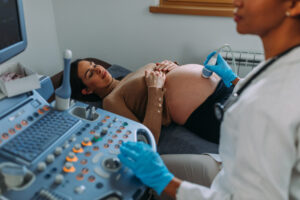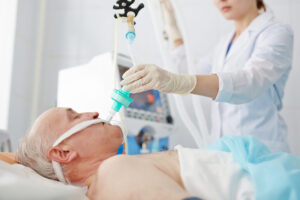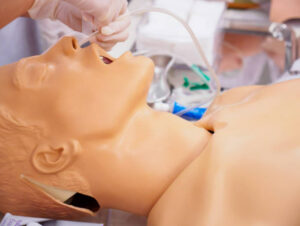Learning objectives
- Pre- and perioperative management of a post-lung transplant patient
Definition and mechanisms
- A post-lung transplant patient may have one or both lungs may be replaced by a donor’s lung, sometimes along with a donor’s heart
- A lung transplant is a surgical procedure to replace a diseased or failing lung with a healthy lung from a deceased donor
- It usually takes at least 3-6 months to fully recover from transplant surgery
- Consider an increased risk of infection or rejection of the transplanted lungs
Indications for a lung transplantation
- Chronic obstructive pulmonary disease (COPD), including emphysema
- Pulmonary fibrosis
- Cystic fibrosis
- Pulmonary hypertension
- Alpha-1-antitrypsin
Symptoms of rejection
- Shortness of breath
- Fever
- Coughing
- Chest congestion
Management
Preoperative assessment
- Investigate:
- The function of the transplanted lung
- The possibility of rejection or infection of the transplanted lung
- The effect of immunosuppressive therapy on other organs and the effect of organ dysfunction on the transplanted lung
- Disease in the native lung
- Indications for the surgical procedure and its effect on the lung
- Evaluate:
- Need for supplemental oxygen
- Pulmonary function tests
- Arterial blood gas
- Chest X-ray
- CT
- ECG
- Echocardiogram
- Complete blood count
- Creatinine
- BUN
- Glucose
- Electrolytes
- Renal function tests
- Liver function tests
- Coagulation tests
- Urinalysis
- Exclude infections
- Take into account possible side effects of immunosuppressive therapy:
- Hypertension
- Renal failure
- Hepatic dysfunction
- Pancreatitis
- Glucose intolerance or diabetes
- Electrolyte abnormalities
- Bone marrow depression
Perioperative management
General
- If possible, continue immunosuppressants until the day of surgery
- Be cautious with anxiolytics as they may lead to hypercarbia
- Administer:
- Immunosuppressants IV if oral agents are precluded
- Prophylactic antibiotics to avoid infection
- Perform standard monitoring
- Avoid:
- Femoral lines → increased risk of infection
- Nasal intubation → increased risk of infection
- Invasive monitoring if not required → risk of infection or pneumothorax
- Place a central line in the antecubital fossa or internal jugular vein → a lower risk of pneumothorax than in the subclavian approach
Anesthesia
- Local, regional, or general anesthesia are all considered safe to use, however, do not perform a block above T10
- Propofol is the anesthetic of choice
- Etomidate is preferred when there is a risk of hemodynamic instability
- Volatile anesthetics are also well tolerated
- Use short-acting relaxants (mivacurium) or intermediate-acting agents independent of kidney and liver function (cisatracurium, atracurium)
- Consider that vecuronium, rocuronium, and pancuronium can have prolonged effects with hepatic or renal insufficiency
- Note that immunosuppressive agents may interact with neuromuscular blocking agents
- Avoid:
- Succinylcholine because of the possibility of hyperkalemia
- Long-acting agents such as pancuronium or doxacurium
Airway management
- Aim for early extubation to minimize the risk of infection
- The Trendelenberg position may further compromise pulmonary function and increase the work of breathing
- Place the endotracheal cuff just beyond the vocal cords to avoid trauma to the trachea or bronchial anastomosis
- Consider using a fibreoptic laryngoscope
- Positive pressure ventilation is complicated in single lung transplant recipients
- Consider differences in lung compliance between the native and transplanted lungs and consequently, two ventilator machines may be required with different ventilator settings
- Avoid:
- Benzodiazepines
- Nitrous oxide
- Positive end-expiratory pressures
- Consider cardiac denervation in patients who have undergone double lung transplantation with tracheal anastomosis
- These patients are sensitive to hypovolemia
- Intraoperative bradycardia does not respond to atropine and direct agents such as epinephrine should be used
Fluid balance
- Monitor central venous pressure, pulmonary artery pressure, and urine output
- Maintain a careful fluid balance
- Consider that altered lymphatic drainage in the transplanted lung may cause interstitial fluid accumulation
- Treat these patients with diuretics and limited crystalloid infusion
Postoperative care
- Transfer the patient to the ICU
- Monitor oxygen saturation
- Administer adequate analgesia:
- Parenteral paracetamol is an effective analgesic agent
- Be cautious with the use of opioids as they can mediate CNS and respiratory depression
- Transdermal buprenorphine and methadone appear to be safe to use even in patients with renal dysfunction
- Avoid NSAIDs because of the risk of adverse reactions
- Seek and treat infection or rejection
- Continue immunosuppressive therapy
Suggested reading
- Brusich, K.T., Acan, I., 2018. Anesthetic Considerations in Transplant Recipients for Nontransplant Surgery. doi:10.5772/intechopen.74329
- Seo M, Kim WJ, Choi IC. Anesthesia for non-pulmonary surgical intervention following lung transplantation: two cases report. Korean J Anesthesiol. 2014;66(4):322-326.
- Haddow, G.R., 1997. Anaesthesia for patients after lung transplantation. Canadian Journal of Anesthesia/Journal canadien d’anesthésie 44, 182–197.
We would love to hear from you. If you should detect any errors, email us customerservice@nysora.com







